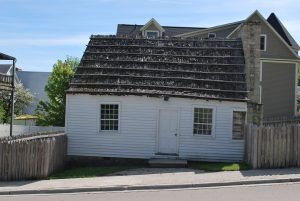If you are walking up Fort Street next to Marquette Park on Mackinac Island, you may notice a small, unassuming house on the left. This is the McGulpin House. While small in stature, it packs a lot of history in its walls.
This is not the original site for the McGulpin House; it was moved to its present location in 1982 to serve as a historic house museum for Mackinac State Historic Parks. It was originally located on Church Street, behind present day Ste. Anne’s Church. Circumstantial evidence indicates it may have been moved from the downtown area of the island, or even from the mainland before the creation of Fort Mackinac. The style of the house does date it at least to ca. 1780, one of the oldest residential homes and buildings in the state of Michigan.

William McGulpin, the first known owner, bought the home in 1817. He was a baker, establishing a bakery on Mackinac by 1820. He had contracts to bake for John Jacob Astor’s American Fur Company and the business of Edward Biddle and John Drew, among others. He and his wife Madeline raised their nine children in the home and lived there for over 60 years. Their son, Stephen, became a lighthouse keeper and McGulpin Point Lighthouse in Mackinaw City is named for him. Many of his descendants still live in the Straits of Mackinac area.

The home itself started as a log structure and is French Colonial style, one of the few remaining examples in Michigan. The style is Piece-Sur-Piece a Queue de Ronde where the logs are laid horizontally and attached at the ends with dove-tailed notches. It has a steep pitched roof with the roof timbers being cut by a pit saw. The roof flares at the end so rain and snow fall quickly and away from the wooden structure.
McGulpin winterized the home with lath and plaster on the interior and clapboard on the exterior. He also enlarged the windows, split a large room into two rooms and added on a fourth room for his family. There were two more additions, the last coming just after 1900. With the moving and opening of the building as a historic structure, it looks as it did when the McGulpin family lived there in the 1820s.
The McGulpin House, along with the other Historic Downtown buildings on Mackinac Island, opened for the season on June 10. Admission to all of these buildings is included with a Fort Mackinac or Richard and Jane Manoogian Mackinac Art Museum ticket.











